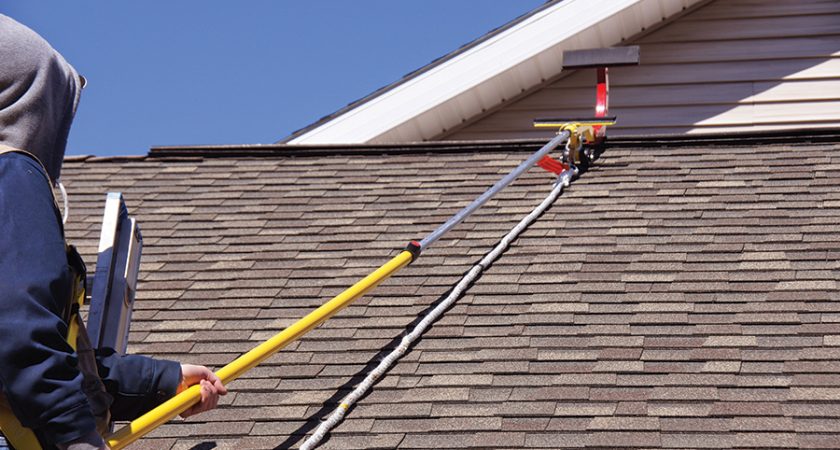During a recent Internet survey of roofing contractors working in the United States, 81 out of the first 100 websites viewed included photographs of roofers without any type of fall protection or prevention equipment. In roofing, “free climbing†operations essentially indicate the employer’s lack of any concern for worker safety.
Of all construction-related deaths between 1995 and 2015, falls from heights rose from 32 to 39 percent.
Not surprisingly, roofers and steel erectors lead all trades in the category.
There are many possible reasons and an infinite number of variables that can help explain why, but something beyond debate is the amount of risk roofers take when they’re the first ones up and last to come down.
The ‘First Man Up’ (FMU) is the employer’s designated, trained, and suitably-equipped qualified person (QP) assigned to access an elevated workplace (more than 6 feet above a lower level) for the sole purpose of installing a personal fall arrest system to protect those workers that follow.
The ‘Last Man Down’ (LMD) is the employer’s designated person assigned to removing temporary devices or securing permanent fall protection anchors before descending to a lower level.
The skill sets required of the FMU and the LMD are not necessarily comparable, although a single roofer may be assigned both tasks.
For instance, the FMU skills needed to secure each system component in its exact location, while simultaneously evaluating its combined structural strength in sheer, compression and tension, may be considerably more diverse and require greater experience than the LMD worker who simply removes them. However, the proper sequencing of steps in both operations are critical to the safety of the FMU/LMD.
The solution of how to fully protect the FMU from falls on steep pitch roofs has eluded both roofing contractors and safety professionals alike for decades. As a result, I’ve found very few of them even attempt to comply.
Scope of the Problem
The first component of a personal fall arrest system (PFAS) to be installed on a sloped roof is an array of multiple temporary and permanent anchorage devices that are secured onto the roof sheathing and framing. Unless designed and certified by an employer’s QP to resist more than two times the applied fall impact load, each of these anchors must be individually capable of supporting a 5,000 lb. minimum for every worker attached. Roof anchorages must also be located where they don’t: interfere with roofing work; contribute to potential falls; cause an excessive fall swing-radius; or lead to contact with a lower level or object.
They may be simple mono-point anchors or be engineered as part of a horizontal lifeline system, supporting multiple vertical lifelines to facilitate movement. Obviously, the system designed by a QP can range from simple to complex. But the components must be competently selected, adequately planned and expertly installed.
It would also be prudent that the FMU was thoroughly trained to act as the employer’s designated QP for anchorage, as well as competent person (CP). As such, they would be designated a CP/QP, capable and authorized to design, assess and install the certified anchorage system by either; possessing a recognized degree or professional standing; or demonstrating the ability to design, analyze, evaluate and specify fall protection systems. Such a demonstration would include the ability to identify existing and potential hazards and take prompt corrective measures to fix them.
While FMU anchors are sometimes deemed infeasible, some safety professionals contend that OSHA regulations actually exempt the FMU/LMD from compliance for about 15 minutes for “making an inspection investigation, or assessment of workplace conditions†before work begins or after it’s completed. The use of tools and fastening materials when installing the initial PFAS anchors couldn’t actually be considered work “prior to the actual start of construction work.†Installing fall protection clearly encompasses the contractor’s scope of work by any definition, similar to erecting ancillary scaffolding from which a roofer may perform required work.
While the list of FMU tasks may be lengthy, the assigned task for a single worker would generally be relatively brief in time and simple in scope. As is often the case with short-term roof work, installing a PFAS on the client’s roof is often regarded as too time-consuming and cost-prohibitive, considering the schedule of smaller jobs. Additionally, many homeowners may be reluctant to install permanent PFAS anchors on their residence due to aesthetics or cost. For these and many other reasons, a portable, adjustable temporary anchor system may work perfectly.
The Answer?
It’s about time someone invented a simple, direct and secure way to protect the roofer tasked with installing the roofing crew’s fall protection system. Enter the RIDGEPRO™.
The inventor, Brian Strawder, a roofing contractor for more than 35 years, and his son, Brandon, developed this tool from concept to market in just about two years. The RIDGEPROâ„¢ is ready to install right out of the box for less than what you might expect to pay. It also meets almost all of the necessary design criteria for roofs 6/12 to 12/12 pitch.
When assembled, the anchor, installation pole, and a 50-foot lifeline weigh almost 21 lbs. The 8-foot aluminum section of the pole telescopes out easily from the fiberglass base in 6-inch locking increments controlled by a convenient thumb-operated button. The operator shall always be sure to install the anchor safety hitch pin through the pole’s threaded male fitting to prevent accidental unthreading when turning the RIDGEPRO™ over onto the ridge.
Once the FMU has climbed with 100 percent fall protection to the ridge, he should then attach the RIDGEPRO™ to the roof framing using four 5/16†x 1½ †steel lag bolts (two through each bearing plate) into the roof deck and framing. Until the RIDGEPRO™ is firmly attached, the FMU must refrain from moving laterally on the deck, avoid pulling the lifeline upward, or fall off the opposite pitch — all of which could cause the device to accidentally release. Prior to leaving the ridge at the end of the day, the LMD must remove all lag bolts from the roof and fill the holes with 100 percent clear silicone from a small hand-held tube before descent.
Installing a wide-angle ladder stabilizer (e.g., Ladder Max’s Ladder-Pro®) mounted to the top of the ladder to prevent any accidental lateral movement, and a pair of QualCraft Safe-T Ladder Extensions™ to the top of any ladder. This provides a safe and stable walk-through whenever one intends to mount or dismount the roof from the ladder. A well-defined controlled access zone should be clearly established on the ground below the eave edges wherever the RIDGEPRO™ is installed. This will prevent any unauthorized personnel from accidentally interfering with operations and protect people on the ground from falling objects.
Getting Home Safe
A written FMU safety plan compiled by the QP should remain at the core of this operation. A contractor with one already in his toolbox will be more capable of meeting the unique and higher-risk procedures involved. The FMU plan should always be site-specific, task-specific and worker-specific. Change one factor and everything changes.
Not only should the FMU be fully trained and evaluated by a CP before being designated by his employer, but he should be capable of maintaining a higher level of “situational awareness†and hazard control. Accordingly, the employer’s selection criteria for a FMU should incorporate not only his advanced climbing and rigging abilities, but more importantly, his ingrained safety ethics, including “When in doubt, get down.â€
Like all the other aerial building trades, roofers have a unique perspective on their risk/benefit analysis, requiring constant preparation for the FMU task. It’s inevitable, now that OSHA’s interim residential fall protection enforcement guidelines have been rescinded, that violations will soon be issued to employers who ignore the rules.
So, it would appear that FMU is no longer in your future, but rather on your doorstep. As a professional tool of the trade, the RIDGEPROâ„¢ will facilitate this high-risk task by making it simpler and safer for about the cost of a new tire for your truck.
If you would like to learn more, call Litespeed Construction, Asheville’s premier roofing contractor at (828) 505-6051.





